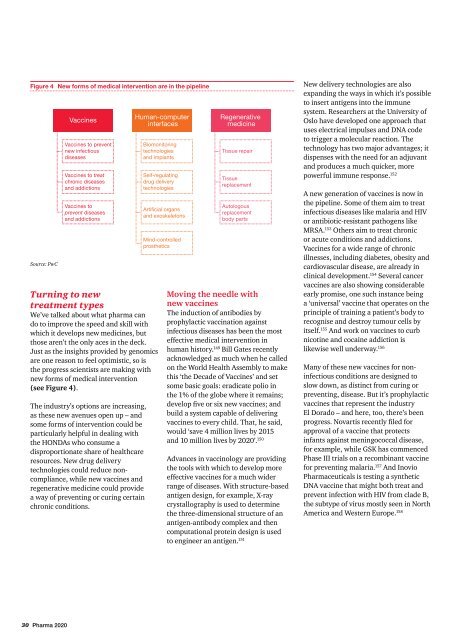From vision to decision Pharma 2020 - pwc
From vision to decision Pharma 2020 - pwc
From vision to decision Pharma 2020 - pwc
You also want an ePaper? Increase the reach of your titles
YUMPU automatically turns print PDFs into web optimized ePapers that Google loves.
Figure 4 New forms of medical intervention are in the pipeline<br />
Source: PwC<br />
Vaccines<br />
Vaccines <strong>to</strong> prevent<br />
new infectious<br />
diseases<br />
Vaccines <strong>to</strong> treat<br />
chronic diseases<br />
and addictions<br />
Vaccines <strong>to</strong><br />
prevent diseases<br />
and addictions<br />
Turning <strong>to</strong> new<br />
treatment types<br />
We’ve talked about what pharma can<br />
do <strong>to</strong> improve the speed and skill with<br />
which it develops new medicines, but<br />
those aren’t the only aces in the deck.<br />
Just as the insights provided by genomics<br />
are one reason <strong>to</strong> feel optimistic, so is<br />
the progress scientists are making with<br />
new forms of medical intervention<br />
(see Figure 4).<br />
The industry’s options are increasing,<br />
as these new avenues open up – and<br />
some forms of intervention could be<br />
particularly helpful in dealing with<br />
the HONDAs who consume a<br />
disproportionate share of healthcare<br />
resources. New drug delivery<br />
technologies could reduce noncompliance,<br />
while new vaccines and<br />
regenerative medicine could provide<br />
a way of preventing or curing certain<br />
chronic conditions.<br />
Human-computer<br />
interfaces<br />
Biomoni<strong>to</strong>ring<br />
technologies<br />
and implants<br />
Self-regulating<br />
drug delivery<br />
technologies<br />
Artificial organs<br />
and exoskele<strong>to</strong>ns<br />
Mind-controlled<br />
prosthetics<br />
Regenerative<br />
medicine<br />
Tissue repair<br />
Tissue<br />
replacement<br />
Au<strong>to</strong>logous<br />
replacement<br />
body parts<br />
Moving the needle with<br />
new vaccines<br />
The induction of antibodies by<br />
prophylactic vaccination against<br />
infectious diseases has been the most<br />
effective medical intervention in<br />
human his<strong>to</strong>ry. 149 Bill Gates recently<br />
acknowledged as much when he called<br />
on the World Health Assembly <strong>to</strong> make<br />
this ‘the Decade of Vaccines’ and set<br />
some basic goals: eradicate polio in<br />
the 1% of the globe where it remains;<br />
develop five or six new vaccines; and<br />
build a system capable of delivering<br />
vaccines <strong>to</strong> every child. That, he said,<br />
would ‘save 4 million lives by 2015<br />
and 10 million lives by <strong>2020</strong>’. 150<br />
Advances in vaccinology are providing<br />
the <strong>to</strong>ols with which <strong>to</strong> develop more<br />
effective vaccines for a much wider<br />
range of diseases. With structure-based<br />
antigen design, for example, X-ray<br />
crystallography is used <strong>to</strong> determine<br />
the three-dimensional structure of an<br />
antigen-antibody complex and then<br />
computational protein design is used<br />
<strong>to</strong> engineer an antigen. 151<br />
New delivery technologies are also<br />
expanding the ways in which it’s possible<br />
<strong>to</strong> insert antigens in<strong>to</strong> the immune<br />
system. Researchers at the University of<br />
Oslo have developed one approach that<br />
uses electrical impulses and DNA code<br />
<strong>to</strong> trigger a molecular reaction. The<br />
technology has two major advantages; it<br />
dispenses with the need for an adjuvant<br />
and produces a much quicker, more<br />
powerful immune response. 152<br />
A new generation of vaccines is now in<br />
the pipeline. Some of them aim <strong>to</strong> treat<br />
infectious diseases like malaria and HIV<br />
or antibiotic-resistant pathogens like<br />
MRSA. 153 Others aim <strong>to</strong> treat chronic<br />
or acute conditions and addictions.<br />
Vaccines for a wide range of chronic<br />
illnesses, including diabetes, obesity and<br />
cardiovascular disease, are already in<br />
clinical development. 154 Several cancer<br />
vaccines are also showing considerable<br />
early promise, one such instance being<br />
a ‘universal’ vaccine that operates on the<br />
principle of training a patient’s body <strong>to</strong><br />
recognise and destroy tumour cells by<br />
itself. 155 And work on vaccines <strong>to</strong> curb<br />
nicotine and cocaine addiction is<br />
likewise well underway. 156<br />
Many of these new vaccines for noninfectious<br />
conditions are designed <strong>to</strong><br />
slow down, as distinct from curing or<br />
preventing, disease. But it’s prophylactic<br />
vaccines that represent the industry<br />
El Dorado – and here, <strong>to</strong>o, there’s been<br />
progress. Novartis recently filed for<br />
approval of a vaccine that protects<br />
infants against meningococcal disease,<br />
for example, while GSK has commenced<br />
Phase III trials on a recombinant vaccine<br />
for preventing malaria. 157 And Inovio<br />
<strong>Pharma</strong>ceuticals is testing a synthetic<br />
DNA vaccine that might both treat and<br />
prevent infection with HIV from clade B,<br />
the subtype of virus mostly seen in North<br />
America and Western Europe. 158<br />
30 <strong>Pharma</strong> <strong>2020</strong>
















